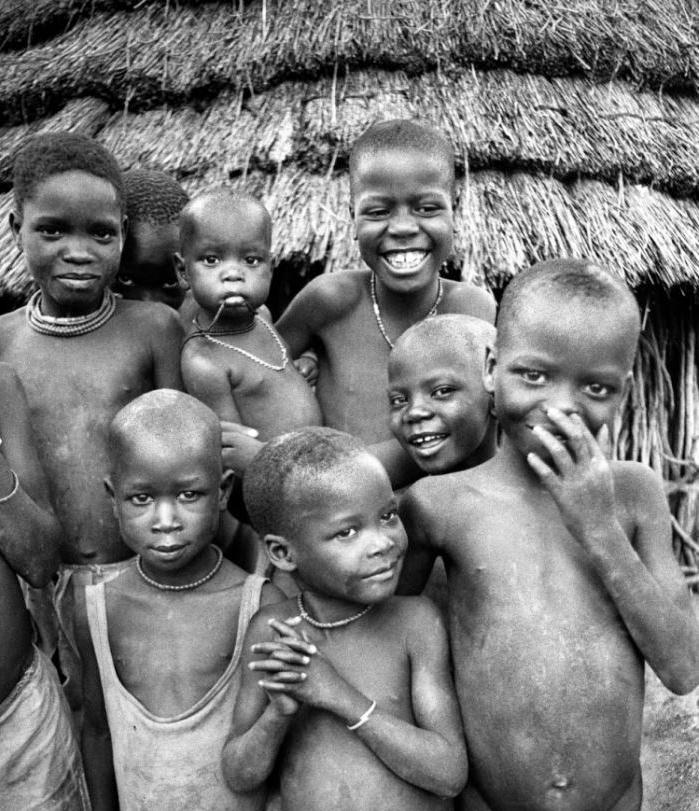
Ugandan Regions: Northern Region--Karamoja

Figure 1.-- The Karamoja is the northeastern region of Uganda. Since 1980s the region has been involved in the Ugandan Civil War and a poorly reported war with the nihlistic Lord's Resistance Army, led by Joseph Kony. The main ethnicity are the Karimojong, a Nilotic group. As other Nilotic people traditionally the clothing was not common, expecially by children and men. (In the Karimojong language there is not a specific term to say naked). The spread of clothing began with used casual garments from Europe that in short time became dirty and torn. So the western style clothing was seen by mamy elderly people as somthing degrading.
|
|
Karamoja is a Ugandan sub-region, the eastern portion of the country's Northern Region.
The primary population of Karamoja are the Karimojong. They are part of the Karimojong Cluster of Nilotic tribes (the Teso Cluster). There are several tribes involved. They speak different languages or dialects, which are mutually intelligibleg. The ethnicity of the Ethur is not entirely certain, but they are regarded as essentially Nilotic (rather mixed) and their language is regarded as a Luo dialect. The Ik and Tepeth have their own languages, but these are under great pressure from the dominant Karimojong language (Ŋakarimojong). Some of the most important finds of ancient homonids have been in East Africa within the Great Rift Valley. A recent fossil find in Karamoja has expaned our kjnowledge of the primates from which humans ghave eviolved. Paleontologists discovered fosillized remains of Ugandapithecus major dating back some 20-million years. It was an ancestor of modern primates. One of the paleontologists reports, "It is a highly important fossil and it will certainly put Uganda on the map in terms of the scientific world." [Pickford] The economy of the area is largely pastoral (especially cattle) and agricultural with some mining. There is trading in agricultural products. The region has been affected by desertification and the expanding Sahara. This has led to increasing conflicts over water. The region has been destabilized by the Uganda Civil War and the Lord's Resistance Army.
The United Nations was involved in a disarmament program, but had to suspend it (2006). U.N. personnel reported human rights abuses in the disarmament programs conducted by the Uganda People's Defence Force (UPDF). There were clashed between the UPDF and nomadic warriors. The UPDF disarmament campaign normally involves UPDF units surrounding manyatas (villages), evacuating civilians, and then searching for hidden weapons. A Human Rights Watch report described considerablkr brutality, including the torture of children. [Human Rights Watch] They also reported that the UPDF High Command was taking action to pursue a more diciplined effort. Clashed were repirted between the UPDF and nomadic warriors (2010). U.N. observers reported thst the UPDP was using a helicopter gunship and ground forces against warrior communities. [Pillay] The UNDP claims to have largely disarmed the area. Press reports, however, claim continuing problems. [Pulitzer Center] Karamojo is the poorest area of Uganda. And the violence in the area has added to other problems for the people there, including environmental issues, insecurity, marginalization, illiteracy, poor health, and poor infrastructure. There are five regional hospitals (Matany, Moroto, Amudat, Kotido, and Kaabong). Districts in Karamoja have the highest Human Poverty Indices (HPI) in Uganda. Nakapiripirit and Moroto Districts having 63.5 percent and Kotido has 53.8 percent of the population living in poverty. The national average is 37.5 percent. The Northern as a wholke has a poverty rate of 46.1 percent, Western region 39.0 percent, and Eastern region 37.1 percent. And poverty rates in the region are rising. Of all the various problems in the region, desertification seems the most serious given the pastoral/agricultural economy. A famine in Karamoja resulted in horrendous mortality rates (1980). [Longhurst] One report indicated that over 20 percebt of the population perished and tragically 60 percent of infants. Desertification leads to poor yields, not only dry spells but actual droughts. The water shortahes also leads to cattle rustling and theresultng communal conflict, insecurity, animal death, and. Also reported are high bride price for marriage, limited skills, unemployment, poor governance, and general landlessness. As a result, people in the region are heavily dependent on the United Nations World Food Programme. Another severe drought occurred (2011). Food shortages were again reported as well as other areas in Northern and Eastern Regions. Conditions in Karamoja and the Bulambuli district were especially bad.
Some 1.2 million Ugandans affected. The Ugandan government reported that acute food hortages were expected in 35 districts. [Ariong, et. al.]
Sources
Ariong, Steven Ariong, James Eriku, Felix Warom and Richard Otim. "Famine bites as families resort to one meal a day," The Monitor (August 19, 2011).
Human Rights Watch (2007).
Longhurst, R. "Famines, food, and nutrition: issues and opportunities for policy and research". UNU Press.
Pickford, Martin. "Ancient primate fossil unearthed". BBC News. (August 2, 2011).
Pillay, Navi. U.N. High Commissioner for Human Rights (June 2010).
Pulitzer Center (April 2011).
HBC

Navigate the Boys' Historical Clothing Web Site:
[Introduction]
[Activities]
[Biographies]
[Chronology]
[Cloth and textiles]
[Clothing styles]
[Countries]
[Topics]
[Bibliographies]
[Contributions]
[FAQs]
[Glossaries]
[Images]
[Links]
[Registration]
[Tools]
[Boys' Clothing Home]
Navigate the Boys' Historical Clothing national pages:
[Return to the Main Ugandan regional page ]
[Return to the Main Uganda page ]
[Return to the Main African page]
[Algeria]
[Australia]
[Belgium]
[England]
[France]
[Germany]
[Ireland]
[Italy]
[Japan]
[Korea]
[Mexico]
[New Zealand]
[Scotland]
[United States]
Created: 8:06 PM 8/28/2018
Last updated: 8:06 PM 8/28/2018



